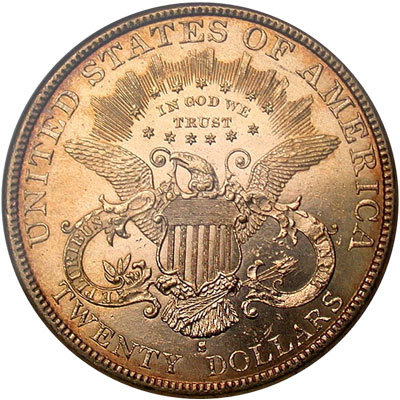Chief engraver James B. Longacre, working at the Mint since 1844, was appointed to design the new twenty dollar gold denomination. His work is featured on many American coinage designs of the 19th century, such as the Indian Head Cent, Shield Nickel, $1 gold and $3 gold pieces. Longacre’s design for the double eagle would be used with minor modifications until the early 20th century.

The obverse of the Liberty Double Eagle features the head of Liberty, en-profile facing left. She is wearing a coronet with the word LIBERTY inscribed. There are a total of thirteen stars around the portrait, with the date appearing below. Except for a few minuscule improvements to the working hub, the obverse design would remain the same until the end of the series.

The reverse design features a version of the heraldic eagle with large scrolls on both sides. The scroll contains the words E PLURIBUS on the left and UNUM on the right, making up the motto regularly found on American coinage. An oval circle composed of thirteen stars appears above the eagle. Inscriptions UNITED STATES OF AMERICA and the denomination spelled as TWENTY D. appear surrounding the image. During the course of the series, the reverse design underwent two noted modifications.
Following the Civil War, the reverse was altered to add the motto IN GOD WE TRUST, placed inside the oval circle of stars. The addition of the motto was first suggested in various forms during the Civil War and was introduced on the double eagles in 1866. A few other minor alterations were made to the reverse design at this time.
The final change to the reverse design was made in 1877. The inscription of the denomination was modified to read in full TWENTY DOLLARS, rather than the prior abbreviated version. Once again, some other minor improvements to the design were made at the same time. This type would be struck until the end of the series.

